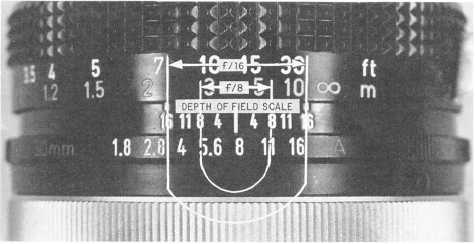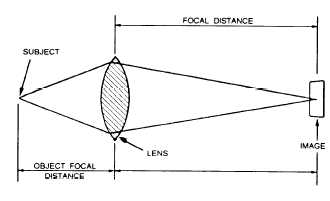302.15
Figure 1-30.–Depth of field on camera focusing ring.
The terms object focal distance and image focal
distance are often used for these conjugate distances. It
is obvious from these two terms that the object distance
is outside the camera and the image distance is inside
the camera. Since the focal length denotes only the
distance from its center to the image when focused at
infinity, we need some way to account for the fact that
when we focus on closer objects the image focal
distance can be much more than the lens focal length,
with a corresponding effect on image size, effective
aperture, and other factors.
50mm +(50mm)
1
= 100mm
The various ratios between image and object focal
distances may be determined by a formula that contains
the focal length of the lens and the ratio (scale) between
the image size and the object size.
That is:
F = the focal length of the lens
R = the ratio between the image and object size
or the ratio between the conjugate foci of
the image and object
When R is determined by the following formula:
R =
Image size
Object size
Object focal distance = F + F
R)
Image focal distance = F + (F x R)
For a 1: 1 reproduction using a 50mm lens, your object
focal distance is as follows:
and the image focal distance is as follows:
50mm + (50mm x 1) = 100mm
When the image formed by a lens is smaller than the
object, the larger conjugate is outside the camera. When
the image formed is larger than the object, the larger
conjugate is inside the camera.
These conjugate focal distances have some
interesting relationships that may be used in several
ways. The following examples illustrate the practical
value of these distance relationships:
EXAMPLE 1: A4x5-inch copy negative must be made
of a 16x20 print using a camera equipped with a 10-inch
focal length lens.
Figure 1-31 .–Conjugate distances.
1-27



